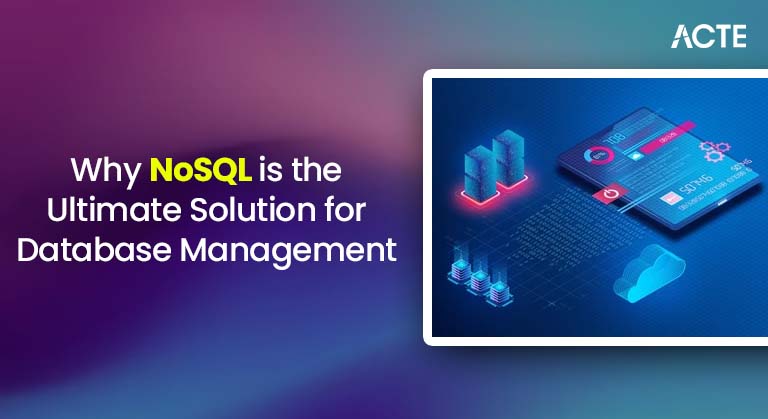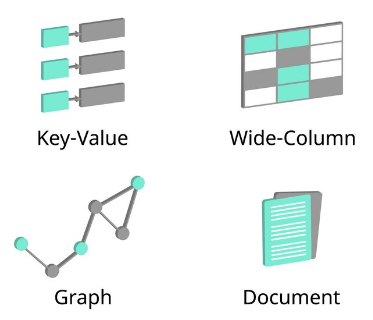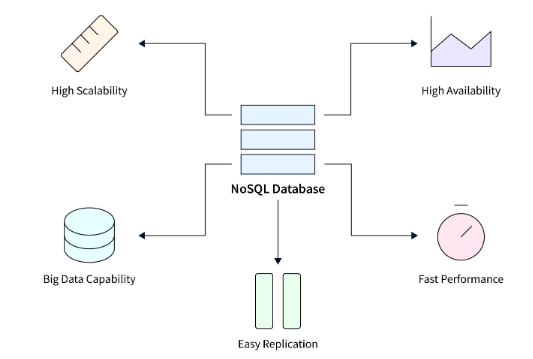
- Rise of NoSQL Databases
- Types of NoSQL: Key-Value, Document, Column, Graph
- Benefits Over Traditional RDBMS
- Schema Flexibility and Speed
- Real-Time Data Handling
- Big Data and NoSQL
- Scalability and High Availability
- Conclusion
Rise of NoSQL Databases
Over the past two decades, the rapid growth of big data, cloud computing, and real-time applications has driven the development and widespread adoption of NoSQL databases. These systems emerged as a response to the limitations of traditional relational database management systems, which rely on predefined structured schemas and the use of SQL for data querying. While relational databases have been the standard for decades and are well suited for handling structured data and complex transactions, they struggle to efficiently manage the vast amounts of unstructured or semi-structured data produced by modern applications. NoSQL databases were designed to address these challenges by offering greater flexibility in data modeling, enabling organizations to store and process diverse data types such as documents, key-value pairs, graphs, and wide-column stores. This adaptability makes NoSQL systems ideal for use cases involving rapidly changing or loosely defined data structures, making them a valuable topic in Database Developer Training. Furthermore, NoSQL databases provide enhanced scalability by allowing horizontal scaling across multiple servers or nodes. This capability is critical for handling the high volume, velocity, and variety of data generated by applications such as social networking platforms, Internet of Things devices, mobile applications, and real-time analytics systems. The ability to scale out efficiently helps organizations maintain performance and availability as their data grows. Additionally, many NoSQL solutions are designed to operate on commodity hardware or cloud infrastructure, reducing costs compared to traditional database systems that often require expensive specialized servers. Overall, NoSQL databases represent a significant evolution in data management technologies, offering an effective alternative for organizations seeking to meet the demands of modern data-driven environments. Their flexibility, scalability, and performance make them a popular choice for a wide range of industries and applications, enabling innovation and new capabilities that were difficult or impossible with traditional relational databases.
Are You Interested in Learning More About Database? Sign Up For Our Database Online Training Today!
Types of NoSQL: Key-Value, Document, Column, Graph
NoSQL databases are broadly categorized into four major types, each designed to address different data storage needs and use cases. The first type is Key-Value Stores, which manage data as simple key-value pairs, much like a dictionary. In this model, each unique key is associated with a specific value, allowing for very fast data retrieval. Examples of key-value stores include Redis and Riak. These databases are especially useful for applications that require rapid access to data such as caching, session management, and real-time data lookups. The second type is Document-Oriented Databases, which store semi-structured data using flexible formats like JSON or BSON, making knowledge of MongoDB Commands Cheat Sheet essential for effective management. These databases allow data to be stored in documents that can have varying structures, making them suitable for applications where the data model evolves over time. MongoDB and Couchbase are popular examples in this category. Document stores are commonly used in content management systems, e-commerce platforms, and any application where flexibility in data representation is critical. The third type is Column-Family Stores. These databases organize data by columns rather than rows, which allows for high performance in both reading and writing operations over very large datasets. Apache Cassandra and HBase are well-known examples. This type of NoSQL database is often used in analytics, logging, and time-series data scenarios where large volumes of data need to be processed quickly. Finally, Graph Databases are designed to manage and query complex relationships between data entities.

Unlike other databases, graph databases like Neo4j and ArangoDB excel in handling connected data and are widely used in social networks, recommendation engines, and fraud detection systems. Their structure allows efficient traversal and analysis of relationships, providing insights that are difficult to obtain with other database models. Each type of NoSQL database serves specific needs, helping organizations choose the best tool for their particular challenges.
Benefits Over Traditional RDBMS
- Horizontal Scalability: Unlike traditional relational databases that typically scale vertically by adding more powerful hardware to a single server, NoSQL databases are designed to scale horizontally. This means they can distribute data and workload across many servers or nodes, allowing systems to handle massive amounts of data and traffic with greater ease and lower cost.
- Flexible Data Models: NoSQL databases do not enforce rigid, predefined schemas. This flexibility allows developers to store unstructured, semi-structured, or rapidly evolving data without complex schema migrations. As a result, NoSQL systems adapt quickly to changing business requirements and diverse data types.
- High Availability and Fault Tolerance: Many NoSQL systems incorporate built-in replication and failover strategies. By maintaining multiple copies of data across nodes, they ensure continuous availability even if some servers fail, which differs from the structured approach of using a Schema in SQL Server.
- Optimized Speed and Performance: NoSQL databases, especially key-value stores and document databases, are optimized for high throughput and low latency operations. Their architecture is geared toward fast read/write access, making them well-suited for real-time applications such as caching, session management, and online gaming.
- Simplified Development: The flexible schema and JSON-like document structures in many NoSQL databases simplify application development. Developers can work more naturally with data formats used in modern programming languages, reducing impedance mismatch and accelerating time to market.
- Cost Efficiency: Horizontal scaling with commodity hardware and cloud infrastructure often lowers operational costs compared to expensive, vertically scaled relational database servers.
- Handling Big Data and Real-Time Analytics: NoSQL databases excel at processing large volumes of diverse data generated at high velocity, supporting big data analytics and real-time insights that traditional relational databases struggle to manage efficiently.
- Schema-less Flexibility: NoSQL databases do not require a predefined schema, allowing developers to store data without rigid structure. This enables agile development and quick changes to data models as application requirements evolve, reducing delays caused by schema migrations.
- Support for Nested and Hierarchical Data: Many NoSQL systems, especially document stores like MongoDB, allow data to be stored in nested, hierarchical formats such as JSON or BSON, which is commonly covered in Database Online Training.
- Agile Development: The absence of strict schemas lets development teams iterate rapidly without needing extensive database redesign. This adaptability accelerates prototyping and feature updates, supporting fast-paced development environments.
- Distributed Architecture: NoSQL databases are built to operate across multiple servers or nodes, spreading data and workload evenly. This reduces performance bottlenecks often seen in centralized systems and increases fault tolerance and availability.
- Low Latency Access: Key-value stores and in-memory NoSQL databases can deliver sub-millisecond response times. This makes them ideal for performance-critical applications such as caching, session management, and real-time analytics.
- High Throughput: By distributing queries and writes across a cluster, NoSQL systems can handle large volumes of simultaneous operations efficiently, supporting high traffic workloads common in social media, gaming, and e-commerce platforms.
- Alignment with Modern APIs: The use of JSON and similar formats aligns naturally with RESTful and GraphQL APIs, simplifying data exchange between backend systems and frontend applications, reducing conversion overhead.
- Massive Scalability: NoSQL databases like Cassandra and HBase are designed to scale horizontally by distributing data across many servers or nodes. This allows organizations to handle petabytes of data efficiently without the limitations of vertical scaling.
- High Write Throughput: These databases are optimized for fast write operations, making them suitable for applications that generate large volumes of data continuously, such as logging, telemetry, and real-time event processing.
- Distributed Data Replication: To ensure data durability and availability, NoSQL systems replicate data across multiple nodes, a concept that contrasts with relational database approaches such as the Types of Joins in SQL Server.
- Data Sharding: NoSQL databases partition or shard data across nodes, dividing large datasets into manageable chunks. This distribution spreads the load evenly, improving performance and supporting parallel processing.
- Eventual Consistency: Many NoSQL systems adopt an eventual consistency model, which allows for temporary discrepancies in data across nodes but guarantees that all replicas will become consistent over time. This trade-off helps achieve high availability and scalability.
- Integration with Big Data Ecosystems: NoSQL databases seamlessly integrate with big data frameworks like Hadoop and Spark, providing storage and fast access to vast amounts of unstructured or semi-structured data required for analytics and machine learning.
- Essential for Big Data Infrastructures: Given their architecture and features, NoSQL databases have become critical components of modern big data infrastructures, supporting use cases in finance, telecommunications, social media, and IoT applications.
To Explore Database in Depth, Check Out Our Comprehensive Database Online Training To Gain Insights From Our Experts!
Schema Flexibility and Speed

Real-Time Data Handling
Real-time applications demand immediate access to data and the ability to process information quickly to provide up-to-the-minute updates and responses. NoSQL databases such as Couchbase and Redis are well suited to meet these requirements because they offer powerful real-time data handling capabilities. These databases often use in-memory processing techniques, which allow data to be stored and retrieved much faster than traditional disk-based systems. This speed is crucial for applications where delays are unacceptable, such as live sports score updates where fans expect instant results as events unfold. Similarly, online gaming platforms rely on real-time leaderboards to display player rankings that update dynamically as games progress, enhancing user engagement and competition. Real-time analytics dashboards are another important use case for these databases. Businesses use these dashboards to monitor operations, track customer behavior, or detect emerging trends as they happen, enabling faster and more informed decision-making, all of which highlight the importance of understanding the basics, such as What is a Database. In financial systems, fraud detection mechanisms depend heavily on real-time data processing to identify suspicious activities immediately and prevent potential losses. NoSQL databases support these demanding scenarios by implementing eventual consistency models, which allow for faster data updates by relaxing strict consistency requirements while ensuring data accuracy over time. Efficient indexing and optimized query capabilities further contribute to the rapid retrieval of relevant data. By combining these features, NoSQL databases like Couchbase and Redis provide a robust foundation for building applications that require high performance and low latency. Their ability to handle large volumes of rapidly changing data in real time makes them indispensable for industries and use cases where timely information is critical to success. As a result, they have become popular choices for developers aiming to deliver responsive and scalable real-time applications.
Big Data and NoSQL
Scalability and High Availability
Scalability is a critical requirement for modern applications that need to handle increasing amounts of data and user traffic without compromising performance. NoSQL databases are designed with scalability in mind and implement several key features to meet these demands effectively. One important feature is auto-sharding, which automatically distributes data across multiple nodes or servers. This allows the database to spread the workload evenly, preventing any single node from becoming a bottleneck. As the volume of data or number of users grows, additional nodes can be added to the cluster to maintain performance and capacity. Another essential feature is replication, where copies of data are stored on multiple nodes. Replication ensures that if one node fails, the data remains available on other nodes, providing fault tolerance and high availability, an essential concept to understand when learning How To Start a Career in Database Administration. This also helps with load balancing because read requests can be distributed among replicated nodes, improving response times and reducing strain on individual servers. Some NoSQL databases, such as Cassandra and Riak, use decentralized architectures based on peer-to-peer models. Unlike traditional systems that rely on a central coordinator, these architectures eliminate any single point of failure. Each node in the cluster has equal responsibility and can handle both read and write operations. This design enhances resilience and allows the system to continue functioning smoothly even when multiple nodes experience issues. Together, auto-sharding, replication, and decentralized architecture enable NoSQL databases to scale horizontally, maintaining responsiveness and reliability under heavy loads. These capabilities make NoSQL solutions ideal for applications that require continuous uptime and the ability to grow seamlessly with increasing demand. As a result, businesses can confidently build scalable and robust systems that support their evolving needs.
Are You Preparing for Database Jobs? Check Out ACTE’s Database Interview Questions and Answers to Boost Your Preparation!
Conclusion
The rise of NoSQL databases represents a significant transformation in the way organizations store, access, and analyze data. Traditional relational database management systems rely on fixed schemas and structured query languages, which can limit flexibility and scalability in today’s data-rich environment. NoSQL databases break away from these constraints by offering more adaptable data models that support unstructured and semi-structured data. This flexibility allows businesses to handle the diverse and rapidly growing volumes of information generated by modern applications, such as social media platforms, Internet of Things devices, and real-time analytics systems. By embracing NoSQL technologies, organizations gain the ability to efficiently manage big data and perform complex analytics in near real time, unlocking insights that drive better decision-making and innovation key concepts often emphasized in Database Online Training. NoSQL databases come in various forms, including key-value stores, document-oriented databases, column-family stores, and graph databases. Each type is optimized for specific use cases, allowing developers and architects to select the most appropriate solution for their unique requirements. This tailored approach enables the creation of scalable, flexible, and high-performing applications that can evolve as business needs change. Moreover, NoSQL databases often support horizontal scaling and distributed architectures, which help maintain performance and availability even under heavy workloads or node failures. As the data landscape continues to expand in both size and complexity, mastering NoSQL technologies becomes increasingly important. Organizations that invest in understanding and implementing NoSQL solutions position themselves to stay competitive and agile in a digitally driven world. NoSQL is not just an alternative to traditional databases but a crucial component of modern data strategies, enabling businesses to harness the full potential of their data assets and adapt to future challenges with confidence.


